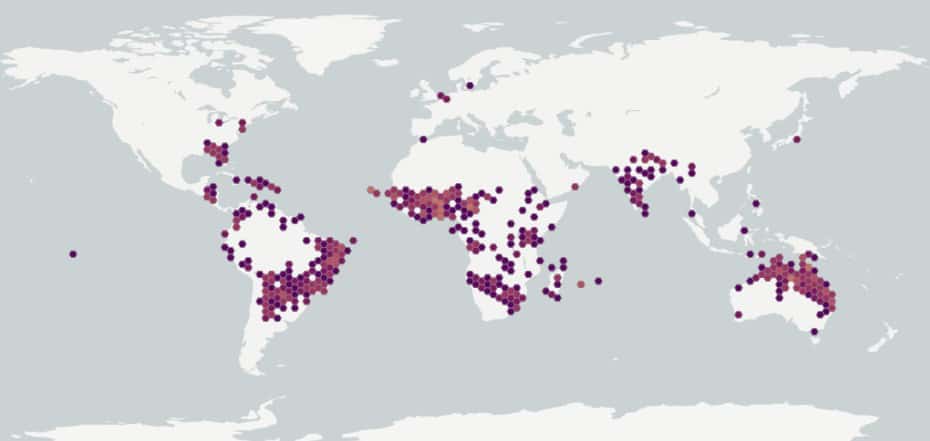Acanthospermum hispidum
Explore More :
Explore plus :
Overview
Aperçu
Regulation :
Remarques Réglementation:
- Quarantine lists of countries e.g. Mexico *may be updated without notice
Regulation Notes:
On quarantine lists of countries e.g. Mexico*.
*Quarantine lists of countries may be updated without notice.
Distribution :
Répartition :
This species is native to Central and South America and the Caribbean (USDA-ARS 2017). It was introduced in Africa, Europe, Asia, Australia and North America (CABI 2017). In the United States, it occurs in Oregon and various northeastern and southeastern states (USDA-NRCS 2017).
Habitat and Crop Association :
Habitat et Cultures Associées :
Hispid starbur grows in cultivated fields, pastures, tree plantations, grasslands, riverbanks, roadsides and disturbed areas. This species reduces crop and pasture yields, mainly in the tropics and subtropics (CABI 2017).
Economic Use, cultivation area, and Weed Association :
Utilisation économique, zone de culture et association de mauvaises herbes :
Duration of Life Cycle :
Durée du cycle vital:
Annual
Dispersal Unit Type :
Type d’unité de dispersion :
Achene
General Information
RENSEIGNEMENTS GÉNÉRAUX
This species is a prolific seed producer, capable of producing a billion short-lived seeds per hectare. The bristly seeds are dispersed on wool, animal fur and clothing, as contaminants in seed and hay, and by water. The plants prefer light, sandy soils (CABI 2017).
.
Acanthospermum hispidum fruit (Rebekah D. Wallace, University of Georgia, Bugwood.org)
Identification
Identification
-
Achene
Size
- Achene length: 4.8 – 6.7 mm (average: 5.6 mm) ; width: 2.1 – 3.1 mm (average: 2.6 mm); thickness 0.5 – 1.0 mm
- Achene two end spines length: 1.5 – 4.1 mm (average: 2.7 mm)
Shape
- Achene is triangular, compressed; with a long spine at the two corners of the broad end
- Four sided in 3 dimensional view
Surface Texture
- Achene surface is densely covered in small (1.0 – 2.0 mm long) spines that have hooked tips, spaces between spines are smooth
Colour
- Light to medium brown achene, both the surface and end spines tend to have darker tips
Other Features
- The achene end spines may be slightly different lengths and may have hooked tips

Hispid starbur (Acanthospermum hispidum) achenes



Identification Tips
CONSEILS POUR L’IDENTIFICATION
Additional Botany Information
AUTRES RENSEIGNEMENTS BOTANIQUES
Similar Species
ESPÈCES SEMBLABLES
Similar species are based on a study of seed morphology of various species, and those with similar dispersal units are identified. The study is limited by physical specimen and literature availability at the time of examination, and possibly impacted by the subjectivity of the authors based on their knowledge and experience. Providing similar species information for seed identification is to make users aware of similarities that could possibly result in misidentification.
Acanthospermum humile DC. (low starbur)
Acanthospermum humile achenes have a similar compressed wedge shape, medium brown colour and one spine from each corner of the broad end.
Acanthospermum humile is generally smaller (average length: 3.6 mm; width: 2.1 mm) than hispid starbur. Low starbur has hooked spines on only one half of the achene surface, is curved to one side and has unequal corner spines; the shorter spine is hooked.
Click to select species
Cliquez pour sélectionner les espèces

Acanthospermum humile
Comparison Window
Fenêtre de comparaison
MAIN SPECIES
ESPÈCES PRINCIPALES
Acanthospermum hispidum

Acanthospermum hispidum
Asteraceae
Hispid starbur (Acanthospermum hispidum) achenes
MAIN SPECIES
ESPÈCES PRINCIPALES
Acanthospermum hispidum

Acanthospermum hispidum
Asteraceae
Hispid starbur (Acanthospermum hispidum) achenes
MAIN SPECIES
ESPÈCES PRINCIPALES
Acanthospermum hispidum

Acanthospermum hispidum
Asteraceae
Hispid starbur (Acanthospermum hispidum) achene
SIMILAR SPECIES
ESPÈCES SEMBLABLES
Acanthospermum humile

Acanthospermum humile
Asteraceae
Low starbur (Acanthospermum humile) achenes
SIMILAR SPECIES
ESPÈCES SEMBLABLES
Acanthospermum humile

Acanthospermum humile
Asteraceae
Low starbur (Acanthospermum humile) achene
Need ID Help?
Besoin d’aide pour l’identification?
Reference(s)
Référence(s)
Centre for Agriculture and Bioscience International (CABI). 2017. Invasive Species Compendium, CAB International, Wallingford, UK. https://www.cabidigitallibrary.org/journal/cabicompendium Accessed April 25, 2017.
Flora of North America (FNA) Editorial Committee, eds. 1993+. Flora of North America North of Mexico [Online]. 22+ vols. New York and Oxford. Accessed December 29, 2022.
Global Biodiversity Information Facility (GBIF) Secretariat. 2022. https://doi.org/10.15468/39omei Accessed via https://www.gbif.org/species/3100375 Accessed December 29, 2022.
U.S. Department of Agriculture-Agricultural Research Services (USDA-ARS). 2017. Germplasm Resources Information Network (GRIN), https://npgsweb.ars-grin.gov/gringlobal/taxon/taxonomysearch Accessed April 25, 2017.
U.S. Department of Agriculture-Natural Resources Conservation Service (USDA-NRCS). 2017. The PLANTS Database. National Plant Data Team, Greensboro, NC USA. https://plants.usda.gov/home Accessed April 25, 2017.




